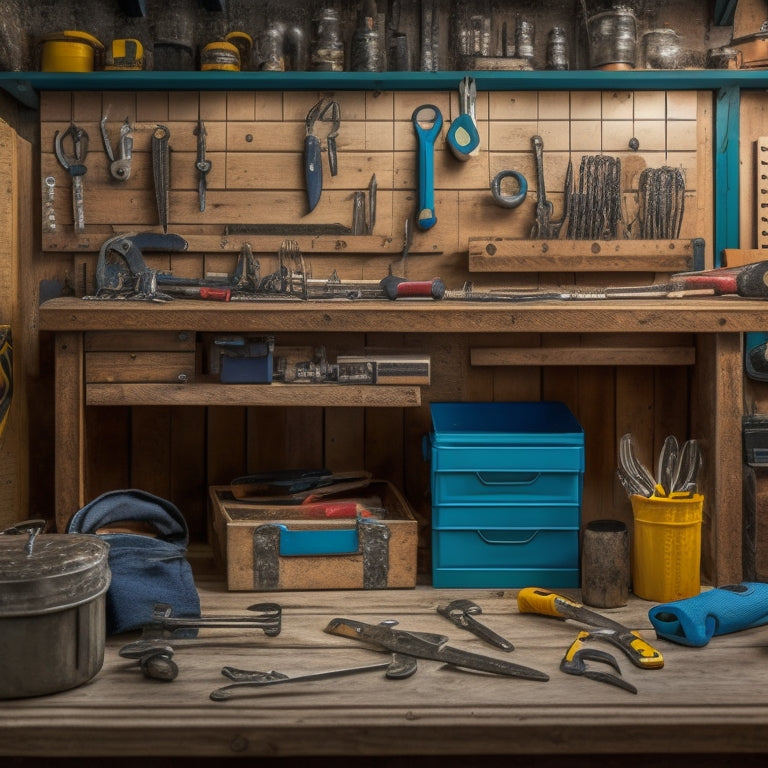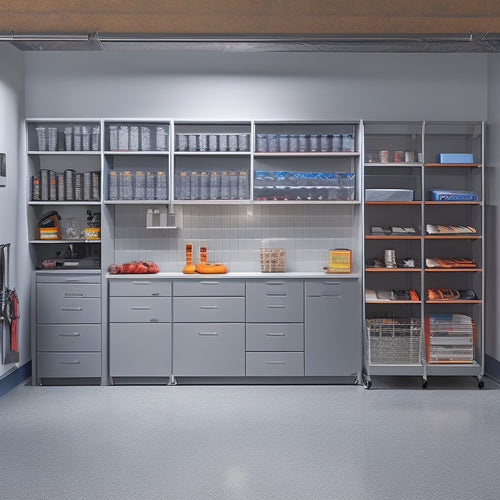
Tool Box Tool Organizer for Boosting Productivity
Share
By optimizing your toolbox with a tool organizer, you can instantly enhance your productivity by up to 30%. A clutter-free and well-structured toolbox enables you to quickly find the tools you need, reducing downtime and increasing the time spent on actual tasks. You'll experience improved tool accessibility, improved time management, and a reduced risk of accidents. With an organized toolbox, you'll be able to focus on tasks, minimize distractions, and complete projects more efficiently. By implementing the right tool organizer system, you'll unlock the full capacity of your toolbox and take your productivity to the next level - uncover how to make it happen.
Key Takeaways
- A well-organized tool box reduces time spent searching for tools, allowing for quicker task completion and increased productivity.
- Implementing a tool organizer system enhances focus on tasks, minimizes distractions, and reduces the risk of accidents from misplaced tools.
- Customizing an organizer system to specific workflow needs optimizes storage space, reduces clutter, and saves time during projects.
- Essential tools, such as fastening, cutting, measuring, electrical, and hand tools, should be organized first to maximize productivity.
- Regular maintenance and cleaning of the tool box and tools prevent clutter, rust, and corrosion, ensuring a safer and more efficient work environment.
Tool Box Organization Benefits
Having a well-organized tool box can be a life-changing factor for any DIY enthusiast or professional. You'll be amazed at how it can enhance your productivity and overall work experience.
With a well-organized tool box, you'll enjoy improved tool accessibility, which means you'll spend less time searching for the right tool and more time getting the job done.
A well-organized tool box also helps with time management. When you know exactly where each tool is, you can quickly grab what you need and get back to work. This saves you time and reduces frustration.
Additionally, a organized tool box reduces the risk of accidents caused by misplaced or disorganized tools. You'll be less likely to trip over tools or cause damage to your workspace.
Choosing the Right Organizer
You'll need to evaluate your tool box's layout when choosing an organizer, as a well-designed system should maximize storage capacity without compromising accessibility.
Think about the types of tools you need to store and the frequency of use, as this will help you determine the most suitable tool storage options.
Tool Box Layout
When it comes to tool box layout, choosing the right organizer is crucial to maximizing storage space and streamlining your workflow. You want to guarantee that your tools are easily accessible, yet safely stored to prevent accidents and injuries.
To achieve this, you'll need to implement effective tool layout strategies. Start by categorizing your tools into groups, such as hand tools, power tools, and accessories. Next, assign a specific place for each group, considering the frequency of use and the tool's size.
For efficient tool placement, consider the "golden zone" – the area between your waist and shoulder height – where you can store your most frequently used tools. This will reduce straining and bending, promoting a safer working environment.
Label each section to maintain organization and make it easier to find what you need. By optimizing your tool box layout, you'll save time, reduce frustration, and increase productivity.
Tool Storage Options
Your tool box's storage capacity is only as good as the organizer you choose. You need a system that keeps your tools within easy reach, protects them from damage, and saves you time searching for what you need.
For portable storage, consider tool bags or tool belts that allow you to carry essentials to the job site. If you prefer a more permanent solution, wall-mounted racks or pegboard systems can be customized to fit your tool collection.
Drawer dividers and stackable bins can maximize the storage capacity of your tool chest, while magnetic strips can hold small metal tools. Rolling carts provide additional storage and mobility.
When selecting a tool organizer, think about your workflow, the types of projects you work on, and the tools you use most frequently. By choosing the right organizer, you'll be able to quickly find what you need, stay organized, and enhance your productivity.
Maximizing Tool Box Space
Most tool boxes have a finite amount of space, and making the most of it's crucial for efficient tool organization. You need to prioritize your tool selection to guarantee you're storing only the most frequently used items. This will help you avoid clutter and make the most of your available space.
When selecting tools, consider the tasks you perform most often and the tools required for those tasks. Store these tools in easy-to-access locations, such as the top tray or in designated compartments. Less frequently used tools can be stored in harder-to-reach areas or in separate storage containers.
To maximize space, use storage techniques like stacking, nesting, and hanging. For example, you can stack small containers or nest tools with similar shapes.
Hanging tools like wrenches, pliers, and screwdrivers can also help free up space. By implementing these strategies, you'll be able to fit more tools in your box and reduce clutter, making it easier to find what you need when you need it.
Customizing Your Organizer System
You'll want to contemplate tool segregation options that cater to your specific needs, such as separating power tools from hand tools or grouping similar tools together.
By doing so, you'll optimize storage space and make it easier to find what you need when you need it.
With a customized system, you'll be able to tailor your organizer to fit your unique workflow and preferences.
Tool Segregation Options
How will you categorize and separate your tools to maximize efficiency and accessibility? Effective tool segregation is vital in a tool box organizer system. You can use color coding to group similar tools together, making them easy to identify.
Magnetic strips can hold small metal tools, keeping them organized and within reach. Drawer dividers and labeled containers can further separate tool categories, such as hand tools, power tools, and fasteners.
Consider using portable organizers or wall-mounted racks to store tools that are frequently used together, like a drill and its bits. Stackable bins can hold bulkier items, like wrenches or pliers.
By segregating your tools into logical categories, you'll reduce the time spent searching for a specific tool, minimizing frustration and increasing productivity. A well-organized tool box also reduces the risk of accidents caused by misplaced or disorganized tools.
Optimize Storage Space
Max out your tool box's storage potential by customizing your organizer system to fit your specific needs. This is where you get to think creatively about space efficiency.
Consider the tools you use most frequently and allocate prime storage space to them. You can install dividers, bins, or trays to create separate compartments for each tool category. This will assist you in locating tools quickly and prevent clutter from building up.
Take advantage of vertical storage solutions to maximize the use of your tool box's walls and ceiling. You can install hooks, pegboards, or shelves to hang tools, accessories, or supplies.
Label each compartment and shelf to guarantee you can find what you need at a glance. By optimizing your storage space, you'll reduce the risk of tool misplacement, damage, or loss.
A well-organized tool box also helps prevent accidents caused by tripping over tools or equipment.
Essential Tools to Organize First
Some toolboxes are so cluttered that finding a specific tool can be a challenging task. To enhance your productivity, it is crucial to organize your tools efficiently. Start by categorizing your essential gear into priority tools, and then sort them using efficient sorting techniques. This will enable you to access the tools you need quickly and easily.
| Tool Category | Essential Tools |
|---|---|
| Fastening | Hammer, Pliers, Screwdrivers |
| Cutting | Utility Knife, Wire Cutters, Bolt Cutters |
| Measuring | Tape Measure, Level, Calipers |
| Electrical | Multimeter, Wire Strippers, Pliers |
| Hand Tools | Wrenches, Socket Set, Pliers |
Maintaining Organization and Cleanliness
A well-organized toolbox is only as good as its maintenance. You've taken the time to set up your tool organizer, now it's crucial to keep it that way. Establish a regular cleaning routine to prevent clutter and dirt from building up. Set aside a few minutes each week to wipe down your tools and the toolbox itself. This won't only keep your tools in good condition but also prevent rust and corrosion.
A clean and organized workspace also contributes to better workspace aesthetics. A cluttered and messy workspace can be overwhelming and even pose safety risks.
By maintaining your tool organizer, you'll be able to focus on the task at hand without distractions. You'll also be able to quickly find the tools you need, reducing the risk of accidents caused by misplaced or damaged tools.
Boosting Productivity With Ease
Most toolboxes are only used at about 50% of their capacity, largely due to poor organization and clutter. This underutilization can greatly hinder your workflow efficiency, making it difficult to complete tasks on time. By implementing a tool box tool organizer, you can enhance productivity with ease.
With a well-organized toolbox, you'll be able to quickly locate the tools you need, saving time and reducing frustration. This, in turn, allows you to prioritize tasks more effectively, tackling the most critical jobs first.
By streamlining your workflow, you'll be able to complete projects faster and with greater accuracy. A tool box tool organizer also helps you stay focused on the task at hand, reducing distractions caused by clutter and disorganization.
Frequently Asked Questions
Can I Use a Tool Box Organizer for a Small Storage Space?
You can definitely use a tool box organizer in a small storage space. Look for space-saving solutions that offer compact storage, like stackable bins or hanging organizers, to maximize your space and keep your tools within easy reach.
Are Tool Box Organizers Only for Hand Tools or Power Tools Too?
Did you know 70% of workplace accidents occur due to poor tool storage? You can rest assured tool box organizers cater to both hand tool storage and power tool organization, keeping your workspace safe and efficient.
Can I Customize an Organizer System for My Specific Tools?
You can definitely customize an organizer system for your specific tools, leveraging various customization options and tool organization techniques to maximize efficiency, ensuring a safe and clutter-free workspace that meets your unique needs.
Do Tool Box Organizers Come With Pre-Drilled Holes for Easy Installation?
When shopping for an organizer, you'll find some options come with pre-drilled holes for easy installation, while others require drilling yourself; consider installation options that prioritize tool accessibility and safety to guarantee a hassle-free setup.
Are Tool Box Organizers Suitable for Outdoor or Harsh Environments?
When working outdoors, you'll want tool box organizers made from weather-resistant materials to guarantee outdoor durability. Look for organizers with rust-proof coatings, waterproof seals, and UV-resistant plastics to withstand harsh conditions and keep your tools protected and organized.
Conclusion
With your tool box converted into a lean, mean productivity machine, you're ready to tackle any project that comes your way. Like a well-oiled engine, your organized tools will hum along, helping you zip through tasks with ease and precision. As you work with confidence and speed, you'll be amazed at how much more you can accomplish in less time, and how a clutter-free space can clear your mind and spark creativity.
Related Posts
-

Heavy-Duty Pegboard Hooks for Industrial Use
You need heavy-duty pegboard hooks that can withstand the rigors of industrial use, providing a reliable and efficien...
-

Building a Garage Storage System With Built-Ins
You're about to build a garage storage system with built-ins that fits your unique needs, starting by evaluating your...
-

What Size Rolling Storage Bin Do I Need
To determine the ideal size of your rolling storage bin, you'll need to measure your storage space accurately, consid...


